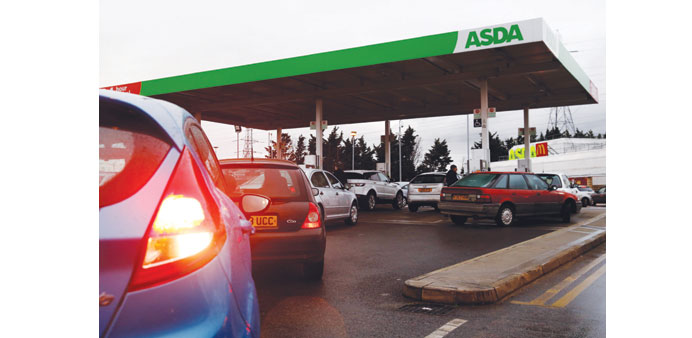Cars wait in line to re-fuel at a gas station in Croydon, UK, yesterday. “Oil consumption is likely to have peaked in the third quarter and demand growth is expected to slow to 1.2mn bpd in 2016, as support from sharply falling oil prices begins to fade,” the International Energy Agency said in its monthly oil report.
Reuters
New York
Oil futures extended their tumble with little pause yesterday, with crude prices hitting their worst levels since the 2008/9 credit crunch, after the International Energy Agency (IEA) warned that global oversupply could worsen next year.
Mild pre-winter weather that reduced heating demand and a plummeting US stock market ahead of a widely expected interest rate hike this month added to the drag.
Brent crude futures slipped below $38 a barrel for the first time since December 2008, trading down $1.69, or 4%, at $38.04 by 11:47 a.m. EST (1647 GMT) after a session low at $37.93.
US crude’s West Texas Intermediate futures entered the $35 territory for the first time since February 2009. WTI was 96¢, or 2.3%, lower at $35.80, hitting an intraday low at $35.67.
“The WTI and Brent markets are trending at this point with no real interest from anyone to buy,” said Scott Shelton, broker and commodities specialist at ICAP in Durham, North Carolina.
“The forecast remains incredibly warm for the US That’s a large drag on demand and means less demand for distillates and more for export, which drags down the rest of the world as well.” US weather forecasts call for warmer-than-normal temperatures through Christmas that would curb heating demand, boosting US gasoline futures higher than heating oil prices in December for the first time in at least five years.
Gasoline’s premium to heating oil for the January contracts widened as the heating oil contract slumped almost 6% while gasoline fell 0.5%.
The IEA, which advises developed nations on energy, warned that demand growth was starting to slow.
“Consumption is likely to have peaked in the third quarter and demand growth is expected to slow to a still-healthy 1.2mn bpd (barrels per day) in 2016, as support from sharply falling oil prices begins to fade,” the energy watchdog said in its monthly oil report.
Crude prices have been in near free-fall the past week after the Organisation of the Petroleum Exporting Countries’ meeting on December 4 failed to impose a ceiling on output, virtually abandoning price support for the market. Data also showed Opec pumped 31.7mn bpd in November, more oil than any month since late 2008.
Banks such as Goldman Sachs have said oil could fall to $20 a barrel if the world runs out of capacity to store unwanted supply.

